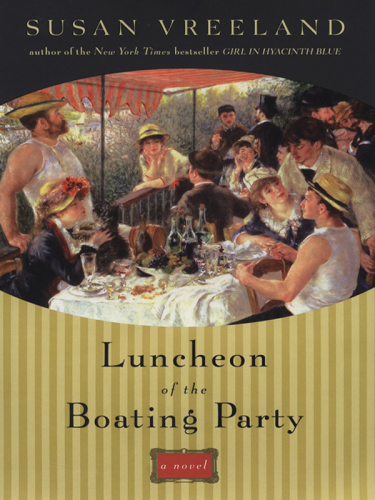
Luncheon of the Boating Party
کتاب های مرتبط
- اطلاعات
- نقد و بررسی
- دیدگاه کاربران
نقد و بررسی

February 19, 2007
Imagining the banks of the Seine in the thick of la vie moderne
, Vreeland (Girl in Hyacinth Blue
) tracks Auguste Renoir as he conceives, plans and paints the 1880 masterpiece that gives her vivid fourth novel its title. Renoir, then 39, pays the rent on his Montmartre garret by painting "overbred society women in their fussy parlors," but, goaded by negative criticism from Émile Zola, he dreams of doing a breakout work. On July 20, the daughter of a resort innkeeper close to Paris suggests that Auguste paint from the restaurant's terrace. The party of 13 subjects Renoir puts together (with difficulty) eventually spends several Sundays drinking and flirting under the spell of the painter's brush. Renoir, who declares, "I only want to paint women I love," falls desperately for his newest models, while trying to win his last subject back from her rich fiancé. But Auguste and his friends only have two months to catch the light he wants and fend off charges that he and his fellow Impressionists see the world "through rose-colored glasses." Vreeland achieves a detailed and surprising group portrait, individualized and immediate.

Starred review from April 15, 2007
One of the most significant paintings of the impressionist period is Renoir's "Luncheon of the Boating Party", and it's hard to imagine that a novel could do it justice. Yet this new work from Vreeland ("Girl in Hyacinth Blue") does just that. She opens with an agitated Renoir eager to respond to criticism from É mile Zola, of all people, that the Impressionists have yet to produce a work of genius measuring up to their claims. Prodded by Alphonsine, whose family owns a restaurant on the river near his mother's home in Louveciennes, Renoir conceives a masterwork that will truly capture "la vie moderne". He will depict a group of "canotiers", or boaters, enjoying a festive lunch on the restaurant's veranda. Then he's off to collect models: Alphonsine, of course, and her brother; the painter Gustave Caillebotte; an actress and a model he has loved; and more. Vreeland weaves together their stories in unaffected prose that at first seems too modest for the painting it describes. In the end, she creates a profoundly moving portrait of the creative process and of a community of people who came together for a moment to help create one great work.] Highly recommended. [See Prepub Alert, "LJ" 1/07.]Barbara Hoffert, Library Journal
Copyright 2007 Library Journal, LLC Used with permission.

Starred review from February 15, 2007
Once again--to the delight of her legion of fans--the best-selling author of " Girl in Hyacinth Blue " (1999) and " The Passion of Artemesia " (2002) imaginatively uses art history as the basis for a carefully constructed historical novel. Vreeland turns this time to French impressionist master Auguste Renoir's famous painting " Luncheon of the Boating Party" , which depicts a group of people (in 1880) enjoying leisure time on the terrace of a riverside restaurant. The current conditions in the life of the painter himself launch the author on an amazingly engrossing reinvigoration of the lives of the individuals who modeled for Renoir for that work, all of whom were actual people, and all are given a third dimension in Vreeland's lovely prose, beyond the two dimensions in which they were painted. Renoir's purpose was to create not only a masterpiece but also a work that would solve the dilemma of his continuing to "belong" to the impressionist school of which he had been a primary founder; in other words, he put his reputation on the line with " Luncheon" . There are, then, basically three levels of "atmosphere" swirling through the pages of this riveting, complex novel: Renoir's issues in composing the painting, the separate and interconnected lives of the 14 individuals appearing in it, and the spirit of " la vie moderne" , the new modes of living, thinking, and expressing as conducted by the French arts community at the time. (Reprinted with permission of Booklist, copyright 2007, American Library Association.)

























دیدگاه کاربران